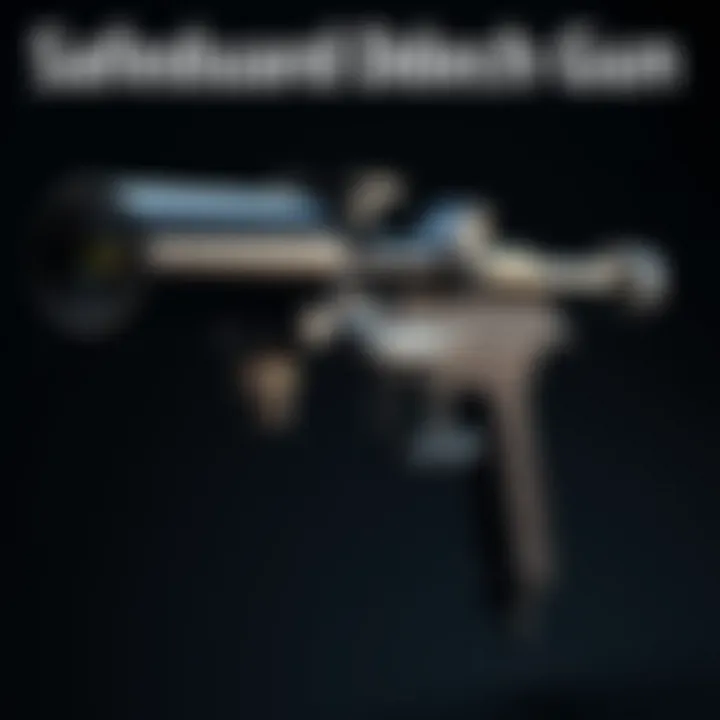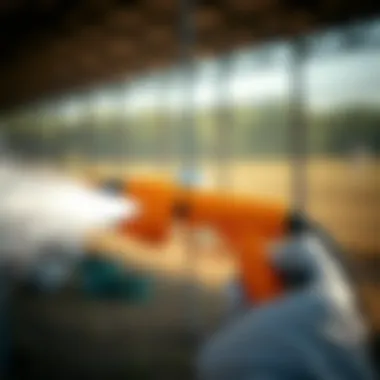Exploring the Safeguard Drench Gun in Agriculture


Intro
In the fast-evolving world of agriculture, tools that enhance efficiency and safety are invaluable. Among these, the safeguard drench gun stands out as a key player. This device, primarily utilized for administering liquids like medications or nutrients to livestock, has seen significant advancements in design and functionality. Understanding its capabilities, applications, and the underlying technology is critical for farmers and horticulture enthusiasts alike.
With a focus on practical insights and best practices, this exploration aims to provide depth and clarity for those looking to enhance their agricultural methods. This artice covers the key points surrounding the safeguard drench gun, its importance in modern farming, and the ongoing trends that shape its usage in everyday practices.
Key Insights
Overview of the Topic
The safeguard drench gun is typically a handheld device designed to deliver precise amounts of liquid to animals orally. Farmers have long recognized the need for efficient delivery methods, and this tool has come to the forefront as an optimal solution. Its ergonomic design allows for ease of use and minimizes stress on both the operator and the animal.
Key features include:
- Accurate dosing mechanisms
- Adjustable nozzles for versatile applications
- Lightweight materials for easy handling
This device not only enhances the efficiency of administering medications but importantly reduces the chances of spillage, wastage, or incorrect dosage—an area where traditional methods sometimes falter.
Importance in Agriculture/Horticulture/Agronomy
The use of the safeguard drench gun has far-reaching implications in agricultural practices. It serves a dual purpose: promoting animal health and optimizing resource use. When used correctly, it aids in improving livestock wellness, which directly correlates to productivity and overall farm profitability. Cattle, sheep, and goats are among the many animals that benefit from its application, aiding in treatment for various health concerns.
In horticulture, while its primary use is with livestock, the principles of precise liquid application have influenced techniques used for plants as well. The transfer of knowledge from animal care to horticulture applications shows the versatility of the technology.
"Effective application of agricultural tools like the safeguard drench gun can lead to healthier animals, sustainable practices, and ultimately, better yield in overall farming efforts."
Sustainable Practices
Eco-Friendly Techniques
Using a safeguard drench gun can contribute to sustainable farming practices in multiple ways. For instance, the accuracy in dosage minimizes waste, ensuring that every drop counts. This is not just beneficial for the environment but also for the pocketbook. Additionally, integrating this tool within a broader sustainable framework can encourage practices such as:
- Organic treatment options: Many farmers are exploring organic solutions that can be delivered through drench guns, minimizing chemical use.
- Water conservation methods: By precisely delivering fluids, the safeguard drench guns help reduce excessive water usage, aligning with modern ecological concerns.
Case Studies on Sustainability
Several case studies illustrate the impact of using safeguard drenches in sustainable agricultural practices. For example, farms that adopted drench guns have frequently reported that they not only enhance animal health but also reduce the environmental impact of livestock treatment. By providing better dosages, farmers have found less runoff of chemicals into the surrounding land and waterways.
Tools & Resources
Essential Equipment and Technologies
Investing in the right equipment is essential for maximizing the benefits of a safeguard drench gun. Some additional tools that complement its use include:
- Calibration tools: Ensuring the gun is accurate in its dosing is imperative. Calibration devices can assist farmers in maintaining correct levels.
- Protective gear: While using any agricultural tool, safety measures should not be overlooked. Ensure the appropriate gloves, goggles, and masks are used when handling medicated solutions.
Recommended Books and Readings
For those interested in delving deeper into the theories and practices surrounding the safeguard drench gun and its application, consider these resources:
Livestock Medicine: A Guide for Vets and Farmers
By arming yourself with this knowledge, you can not only enhance your own agricultural practices but also contribute to a broader movement towards sustainability in farming.
Prelude to the Safeguard Drench Gun
The Safeguard Drench Gun has become an essential tool within agricultural settings. Its significance stretches beyond simple application; it embodies a shift in how farmers and horticulturists can efficiently provide necessary liquids to their crops and livestock. By learning about the Safeguard Drench Gun, we uncover a vital instrument that enhances productivity and promotes better practices.
Definition and Purpose
The Safeguard Drench Gun is a specialized device used to administer liquid substances directly into the mouth or throat of animals or plants. This can include medicinal treatments, nutritional supplements, and even pest control solutions. Unlike traditional methods that could be time-consuming or inefficient, this tool allows users to deliver precise dosages quickly, making it invaluable in both livestock management and horticulture.
The main purpose of the Safeguard Drench Gun is to ensure that those liquids reach their target efficiently and effectively. Quick operation minimizes stress for the animals or plants while enhancing the absorption of nutrients or treatments. In agricultural circles, where time is often of the essence, the Safeguard Drench Gun stands at the forefront of practical solutions. Its design combines functionality with ease of use, ensuring that even less experienced users can operate it without trouble.
Historical Context
The journey of the Drench Gun traces back to a time when agriculture relied heavily on manual methods for administering treatments. In the past, farmers relied on basic syringes or even hand-held water pots, which often resulted in inaccurate dosing and wastage. With the demands of modern agriculture growing, the need for more efficient tools became apparent.
As technology evolved, so too did the designs and mechanics behind agricultural tools. Drench guns began to appear, offering improved functionality. The introduction of the Safeguard Drench Gun marked a significant advancement, equipped with features aimed at enhancing reliability and user experience. Its historical development illustrates a response to the complexities of farming and the continuous quest for improvement.


In summary, the Safeguard Drench Gun serves multiple purposes that reflect its inherent value in today’s agricultural landscape. Understanding its definition and historical background enables users to appreciate not just the tool itself, but the evolution of agricultural practices. The ongoing narratives of innovation in this field lead us to explore deeper into its design, applications, and overall impact on farming.
Design Features of the Safeguard Drench Gun
The design features of the Safeguard Drench Gun are not just a matter of aesthetics; they play a crucial role in the efficiency and effectiveness of the tool. Understanding these design elements enables users to appreciate how the tool functions within agricultural practices. The thoughtful integration of materials, mechanics, and ergonomic considerations all converge to make this device indispensable in farming and horticultural tasks.
Material Composition
When it comes to the construction of the Safeguard Drench Gun, the choice of materials is paramount. The body is often made of high-density polyethylene (HDPE), which is not just durable but also resistant to most chemicals used in agricultural applications. This is essential since the drench gun may frequently encounter harsh substances. The nozzle, usually crafted from stainless steel, offers not just longevity but also the ability to maintain integrity under pressure.
A critical aspect of material composition is the weight of the drench gun. When lighter materials are used, it reduces fatigue during prolonged use. This means farmers can use the tool for longer periods without tiring easily, which is important during busy planting or treatment seasons. Lastly, the materials must be easy to clean, ensuring that residue from potent chemicals does not compromise future applications.
Mechanics and Operation
The mechanics behind the Safeguard Drench Gun are designed for precision and ease of use. The device usually operates on a simple yet effective principle: pressurized liquid is delivered through the nozzle directly into the target. This can be done through a hand pump, often found on some models, or through a more advanced pressurized system that connects to a water source.
A key operational feature is the adjustable flow rate, which allows users to customize the amount of liquid dispensed. This ability to modify the flow means that it can cater to various applications, whether it’s drenching livestock or nourishing plants. The trigger mechanism is another vital element; a well-designed trigger ensures a smooth, consistent flow without unnecessary interruptions.
“Precision in operation reduces waste and maximizes benefit, crucial for any serious agriculture practitioner.”
Proper maintenance of these mechanical components is indispensable. Regular checks can prevent clogs and ensure the longevity of the equipment. Users should be familiar with the basic mechanics to troubleshoot common problems that may arise during operation.
Ergonomics and Ease of Use
Adopting an ergonomic design in the Safeguard Drench Gun makes a significant difference in user experience. The shape of the handle, for instance, impacts how well users can grip the device, especially when it’s full and heavy. Using a cushioned or contoured grip can minimize strain on the hands and wrists, an important consideration for farmers who often face repetitive movements.
Another aspect of ergonomics is the overall weight distribution of the gun. Ideally, it should balance out so that the weight does not pull down on the user’s wrist. Ease of maneuverability is also a factor; a well-designed pivoting nozzle allows farmers to reach different angles without struggling.
Finally, the ease of assembly and disassembly for cleaning is a must-have. Complicated designs can lead to frustration, especially after a long day’s work. The best designs will allow for quick disassembly, enabling users to maintain their tools with little hassle, keeping them in top shape for future tasks.
Applications in Agriculture and Horticulture
The role of the safeguard drench gun in agriculture and horticulture cannot be overstated. Its applications in these fields are pivotal for ensuring both plant health and livestock well-being. Understanding how to effectively use this tool allows farmers to increase productivity while minimizing labor intensity and optimizing resources. The crux of this section is to dive into two primary areas: drenching techniques for livestock and strategies for plant nutrition and pest management.
Drenching Techniques for Livestock
Drenching, in essence, is the application of liquid medicine or nutrient solutions directly into the mouths of livestock. This method is especially effective for administering treatments and supplements that are necessary for maintaining animal health. When using the safeguard drench gun for livestock, the process becomes more efficient and less stressful for both animals and handlers.
One significant benefit of using a drench gun over other methods is the precision it offers. With a properly calibrated drench gun, farmers can control the dosage of liquid administered. This is vital because over or under-dosing can lead to ineffective treatment or potential toxicity. In addition, the technique is less invasive than injections, which can reduce stress on the animals. Practicing proper drenching techniques—such as ensuring the nozzle is directed towards the back of the throat—can significantly enhance acceptance of the drench, leading to improved efficacy.
Here are several key considerations for effective drenching techniques:
- Use appropriate dosage: Different livestock species require varying volumes; thus, knowing the specific needs is crucial.
- Comfort and restraint: Some animals may resist the drenching process. Using gentle restraint techniques and ensuring a calm environment can help mitigate resistance.
- Consistency of product: Ensure that liquids administered are homogeneous; shaking containers before use can ensure uniform distribution of ingredients.
Plant Nutrition and Pest Management
The safeguard drench gun also shines in the realm of plant nutrition and pest management. Through targeted application of nutrients and pest control solutions, farmers can boost plant health and crop yield efficiently. Unlike broadcasting or foliar applications, drenching delivers nutrients directly to the soil or root zone, improving uptake.
Incorporating nutrients directly into the soil can enhance both the efficiency of nutrient use and overall crop performance. By using the drench gun, a farmer can apply more concentrated solutions without the risk of runoff or nutrient loss that can occur with other application methods. This means greater effectiveness in correcting nutrient deficiencies or maintaining optimal plant health throughout the growing season.
Drenching is also a valuable method for managing pests and diseases. It allows for application of biological pest control agents or systemic pesticides that can be absorbed by the plant, promoting longer-lasting protection. Targeted application is key here; it can minimize exposure to non-target organisms, a pressing concern in today’s environmentally-conscious farming.
Consider the following when using a drench gun for plant applications:
- Soil moisture: Ensuring the soil is adequately moist can enhance nutrient absorption, especially when dealing with dry conditions.
- Timing: Certain times in the growth cycle are more conducive to nutrient uptake. For example, applying nutrients during active growth phases yields the best results.
- Compatibility of products: Not all nutrients or pesticides can be mixed. It’s essential to consult product guidelines and conduct small-scale tests to avoid antagonistic reactions.
When conducted properly, drenching enhances plant health, ensures effective pest management, and streamlines the application process, ultimately driving better crop yields and livestock health.
Navigating through these applications with the safeguard drench gun can undoubtedly transform agricultural practices, ensuring that both livestock and crops thrive under optimized conditions.
Efficacy and Performance Metrics
When it comes to the safeguard drench gun, understanding its efficacy and performance metrics isn't just a luxury; it's a necessity for any agricultural professional or horticulture enthusiast. The effectiveness of this tool can greatly influence overall farm productivity and efficiency. It's about knowing how well this device works in real-world scenarios and what metrics can guide its optimal use.
Effectiveness in Various Conditions
The performance of the safeguard drench gun can vary depending on a myriad of factors, including environmental conditions, type of application, and the specific formulation of the products used. For instance, in high humidity areas, the distribution of a drench may differ compared to arid climates where evaporation rates are higher.
- Temperature can play a significant role. Colder temperatures might slow down the action of nutrients while warmer conditions can enhance the absorption rate.
- Soil type influences how effectively fertilizers or medicaments are soaked in. Sandy soils drain quickly but might require more frequent applications than clayey soils.
- Plant type is also crucial. Some plants uptake solutions differently based on their root structure and health.


"The right conditions can amplify the effectiveness of the drench gun. Knowing how to adjust your methods based on environmental factors is key to successful applications."
In scenarios where livestock is concerned, monitoring animal stress levels during application proves vital. A calm animal can be drenched more effectively, ensuring that the intended product targets the right issues. Hence, adapting to conditions is not just a thought; it's a shovel-to-the-ground reality.
Comparison with Alternative Methods
While a safeguard drench gun stands out in many ways, comparing its performance with alternative methods is essential. Understanding these comparisons can help professionals make informed decisions about their equipment.
- Oral dosing syringes may offer precision but can be labor-intensive, especially in large livestock farms. Drench guns provide mass application, which saves time.
- Injectable solutions can yield quick results but risk potential trauma to the animal and often require specialized knowledge to ensure proper administration. The drench gun, meanwhile, offers a less invasive option for treating animals.
- Traditional spraying methods may not deliver as much solution directly where it’s needed. Drenching techniques, on the other hand, can ensure direct absorption at root level or within the digestive system, maximizing nutrient uptake.
To summarize, the safeguard drench gun excels in efficacy by delivering solutions tailored to environmental conditions while proving more user-friendly compared to some of its alternatives. This level of effectiveness makes it a foundational tool in modern agriculture, blending seamlessly into both large-scale operations and small farms alike. Understanding these metrics not only aids in immediate decision making but also shapes the future strategies of agricultural development and sustainability.
Safety Considerations
When working with the Safeguard Drench Gun, safety is paramount. A device designed to administer medications and nutrients to livestock or plants can present genuine risks if not handled properly. Understanding these risks and implementing effective safety protocols not only protects the user but also ensures the well-being of the animals or plants being treated. In this section, we'll discuss safe handling practices and protective measures to minimize hazards associated with using this vital agricultural tool.
Safe Handling Practices
Handling any machinery, including the Safeguard Drench Gun, requires careful attention and strict adherence to safety practices. Here are some essential guidelines:
- Read the Manual: Always start by thoroughly reviewing the manufacturer’s instructions. This document contains vital information regarding proper use, maintenance, and troubleshooting of the device.
- Inspect Equipment Before Use: Prior to each use, check the drench gun for any signs of wear and tear, such as damaged seals or clogged nozzles. Ensuring that all components are in good condition can prevent accidents and ensure optimal performance.
- Proper Lubrication: Ensure moving parts are lubricated correctly to prevent malfunction and ensure smooth operation. Use lubricants recommended by the manufacturer to avoid chemical reactions that may harm the equipment.
- Controlled Environment: Try to work in a calm environment. Both livestock and the user can experience stress, which can lead to accidents. Keeping the area free from distractions and hazards is crucial.
"Safety first is safety always" – a mantra that should echo in the minds of all agricultural professionals.
- Use the Right Technique: When drenching, ensure that you hold the device correctly and maintain a firm grip. This reduces the risk of dropping it and injuring yourself or others.
- Practice Makes Perfect: If you’re new to using a drench gun, practice on inanimate objects to gain confidence. This is especially useful when working with livestock, as they can be unpredictable.
Protective Measures for Users
Even with proper handling, it's crucial to incorporate protective measures to ensure user safety while using the Safeguard Drench Gun. Here are some recommended precautions:
- Personal Protective Equipment (PPE):
- Wear Appropriate Clothing: Long sleeves and pants can help protect skin from splashes and contaminants. Avoid loose clothing that could catch on equipment.
- Keep a First Aid Kit Handy: In case of any mishaps, having a fully stocked first aid kit on-site enhances preparedness. Ensure you and your colleagues know its location.
- Emergency Drill: Conduct periodic drills on how to respond in case of exposure or injury. Knowing how to react quickly and effectively can save lives.
- Training and Supervision: New users should seek training either from experienced colleagues or through professional programs. Supervision can provide new users with the confidence needed to handle the drench gun responsibly.
- Gloves: Wear chemical-resistant gloves to protect your hands from harsh chemicals or medications that might splatter.
- Goggles: Eye protection is necessary to guard against accidental splashes. A good pair of goggles or safety glasses can be a game changer.
- Face Masks: Especially when handling powders or aerosol formulations, wearing a face mask can help prevent inhalation of harmful substances.
Taking these safety precautions not only protects the user but fosters a culture of safety within agricultural operations. This proactive approach enhances overall productivity and reduces the likelihood of accidents while ensuring that the Safeguard Drench Gun serves its intended purpose effectively.
Environmental Impact and Sustainability
The topic of environmental impact and sustainability is crucial to the agricultural sector today. With global challenges such as climate change and biodiversity loss, every tool and method utilized in farming faces scrutiny about its ecological footprint. The Safeguard Drench Gun is no different; understanding its environmental implications can help users make informed decisions. It is about finding a balance between productivity and preserving the earth's resources for future generations.
Chemical Usage and Its Implications
When it comes to drenching, the type of chemicals used can vary widely. The Safeguard Drench Gun provides the ability to apply necessary treatments through precise dosage and targeted strategy. However, the implications of chemical use extend beyond immediate effectiveness. Over-reliance on certain chemicals can lead to soil degradation, water contamination, and potentially harmful effects on non-target organisms, such as beneficial insects and wildlife.
- Soil Health: Excessive use of fertilizers or pesticides can result in nutrient imbalances. A decrease in soil quality can significantly hamper crop yields over time.
- Water Supply: Chemicals can leach into the ground and make their way into nearby water sources. This can affect local ecosystems and even drinking water supplies.
- Pollinator Safety: Many agricultural chemicals can adversely impact pollinators and other beneficial insects, which are essential for crop production. Protecting these species ensures ecosystem balance and sustainable agriculture.
It's vital for users to stay informed about the specific chemicals being utilized, aiming to choose options that minimize environmental harm. Furthermore, following label instructions and understanding local regulations can prevent detrimental practices and foster more sustainable outcomes.
"Sustainable practices pave the way for a healthier planet, turning the tide for agriculture in our delicate ecosystem."
Strategies for Eco-Friendly Practices
Adopting eco-friendly practices doesn't mean compromising yield or efficiency. In fact, many farmers have found that sustainable practices can lead to both economic benefits and environmental health. Here are some strategies for using the Safeguard Drench Gun in a more environmentally conscious manner:
- Integrated Pest Management (IPM): This strategy emphasizes using a combination of biological, cultural, mechanical, and chemical tools. By relying on a variety of techniques, a farmer can minimize chemical applications without sacrificing crop health.
- Precision Agriculture: Leveraging technology to fine-tune applications can reduce the required amount of chemicals significantly. Imagine using sensors and data analytics to apply treatments precisely where and when needed, reducing runoff and wasted products.
- Education and Training: Continuous learning is key for agricultural professionals. Workshops and courses on sustainable practices can provide valuable insights into eco-friendly methods, including effective use of the Safeguard Drench Gun.
- Product Selection: Opting for organic or less harmful chemicals can make a big difference. Products that are designed to be environmentally friendly can reduce negative side effects, making them more suitable for long-term use.
By implementing these strategies, agricultural users can enhance their practices while contributing to the overall sustainability of the farming industry. The goal is not merely to sustain but to regenerate, fostering a healthier planet while meeting agricultural demands.
Best Practices for Users
When handling the Safeguard Drench Gun, following best practices is paramount to ensure not only efficacy but also safety and longevity of the tool. These practices guide users in preparing the device efficiently and provide crucial instructions for post-application, ultimately impacting both the operational efficiency and the health of the livestock or crops involved.
Preparing the Drench Gun for Use
Before stepping into the field, it's essential to properly prepare the Safeguard Drench Gun. The process may seem straightforward, but overlooking even a tiny detail can lead to suboptimal results or accidents. Here are the steps that should never be skipped:
- Check Equipment Condition: Inspect the gun for any signs of wear and tear. Look for cracks, leaks, or clogs in the nozzle that can affect the dispensing accuracy.
- Calibrate the Drench Gun: Ensure the device is calibrated correctly according to the manufacturer's specifications. Miscalibration can cause under or over-dosing, affecting the health of livestock or plants.
- Select Appropriate Drench: Make sure the drench solution is suitable for the intended purpose. Whether it's a nutritional supplement or a pesticide, using the correct mix increases the effectiveness of the application.
- Fill the Reservoir Carefully: When loading the solution, do this methodically to avoid spills. A messy gun can yield inaccurate doses and could pose health risks to both user and animal.
- Test the Drench Gun: Before actual use, it’s wise to do a quick test run. Dispensing a small amount of the solution helps ensure that the system is functioning correctly and that the desired dosage is achieved.
"Proper preparation not only leads to better outcomes but also ensures the safety of users and their livestock."


By taking these steps, users set themselves up for success, ensuring their time in the field is productive and their investments in resources are garnered optimally.
Post-Application Procedures
Once the application is done, the job is far from over. Proper post-application procedures are vital for ensuring that the equipment remains functional and that the safety of both users and animals is prioritized. Here's what to keep in mind:
- Clean the Equipment Thoroughly: After use, rinse the drench gun with clean water to avoid residue buildup that could affect future gallons of solution. Pay special attention to the nozzle and any other parts that come into direct contact with drench.
- Drain Any Remaining Solution: It's critical to empty any leftover solution from the reservoir. This helps avoid cross-contamination in future applications. Store the drench gun dry to prevent corrosion.
- Inspect After Use: Conduct a thorough inspection once more to check for any damages incurred during application. Early identification of issues can prevent costly repairs or replacements down the line.
- Store Properly: Follow the manufacturer's guidelines on storage. Keep the gun in a cool, dry place, ensuring it's sheltered from extreme temperatures or direct sunlight, which can degrade materials over time.
- Document Results: Keep a record of what solutions were used, the amount administered, and the response observed in the livestock or plants. This information can be invaluable for adjusting future applications.
By adhering to these post-application practices, users safeguard not only their equipment but also the health of their livestock and success of their farming ventures. Taking these steps ensures a longer life for the drench gun while maximizing its efficiency in agricultural applications.
Industry Trends and Innovations
The agricultural sector is always evolving, and the safeguard drench gun is not left behind. Observing industry trends and innovations is crucial for understanding how these changes shape drenching practices. From enhanced technology to sustainable methods, each advancement plays a role in improving efficiency and minimizing negative impacts.
Emerging Technologies in Drench Application
Recently, some remarkable leaps have been made in the design and functionality of drench guns. Manufacturers are utilizing smart technology to create models equipped with sensors that ensure precise dosages of liquid are administered. This level of accuracy not only maximizes the effectiveness of treatments but also conserves valuable resources.
For instance, the integration of IoT (Internet of Things) capabilities allows farmers to monitor application effectiveness remotely. By collecting real-time data, they can make necessary adjustments on-the-fly, increasing overall agronomic success. Another noteworthy development is the rise of self-cleaning mechanisms in drench guns. These features not only save time but also reduce the risk of cross-contamination between treatments, ensuring that each application is as effective as possible.
“In farming, staying ahead of technology is not just an advantage; it's a necessity.”
Future Directions of Drench Gun Development
Looking ahead, the direction of drench gun development seems promising and progressive. One of the significant trends is the push toward eco-friendly materials. More manufacturers are exploring biodegradable plastics and other sustainable options that can reduce environmental footprints. As consumers become increasingly ecologically conscious, the adoption of greener alternatives can set a brand apart in a crowded market.
Moreover, advancements in precision agriculture hold significant potential for the future of drench applications. Utilizing drones and GPS technology, farmers may soon be able to apply drenches with pinpoint accuracy across vast areas. This approach not only optimizes the usage of resources but also ensures better crop health and increased yields.
To stay relevant, training and education in new methodologies will emerge as a necessity. Farmers will need to adapt quickly to not only embrace these technologies but also to master them. This whole ecosystem of innovation leads to promising developments in productivity and sustainability, ensuring that the safeguard drench gun remains a relevant tool in modern agriculture.
User Reviews and Case Studies
User reviews and case studies offer a vital lens through which we can understand the effectiveness and real-world application of the Safeguard Drench Gun. By gathering firsthand experiences from those who have employed this tool in various agricultural settings, we draw insights that transcend theoretical knowledge. These narratives not only highlight the practical benefits of the drench gun but also reveal any challenges users may face. Analyzing feedback provides a dual perspective: appreciating its advantages while acknowledging areas for potential improvement.
Feedback from Agricultural Professionals
In the world of agriculture, professionals are no strangers to scrutiny. Their twin goals of productivity and sustainability put them in a unique position to evaluate the Safeguard Drench Gun rigorously. Many users express high satisfaction with its design and functionality, emphasizing how it streamlines the administration of drenching solutions.
For example, Jane, a cattle farmer from Texas, mentioned that the drench gun allows her to administer medications swiftly, which is essential during calving season when time is of the essence. Similarly, Mark, an orchard owner in California, stated that the ease of use of the drench gun has significantly reduced labor hours, allowing them to focus on other critical farm operations.
Feedback often points to the ergonomic design, which reduces strain during prolonged use. However, professionals are not shy about sharing constructive criticism. Some users have noted the learning curve associated with its operation, particularly for those new to drenching techniques. Overall, direct testimonials reinforce the drench gun's value while also promoting continuous improvement.
Learning from Practical Applications
Understanding the practical implications of any agricultural tool, including the Safeguard Drench Gun, is essential for effective utilization. Case studies shed light on how different farmers adapt the drench gun to their specific needs. Take the case of a poultry farmer in Mississippi who faced high mortality rates due to respiratory issues among the birds. After incorporating the drench gun into her regimen, the mortality rate dramatically decreased.
The farmer contoured her approach by developing a routine that utilized the drench gun for preventative health measures. This not only saved her from the economic burden of loss but also improved overall flock health. This example speaks volumes about the drench gun's versatility and impact.
Moreover, case studies often showcase innovations implemented by users as they adapt the technology. A community co-op in Oregon devised a training program for local farmers to better understand the drench gun. This initiative emphasized knowledge-sharing and collective problem-solving, resulting in a marked improvement in the application among community members.
Practical examples like these shape how the Safeguard Drench Gun is perceived and utilized in various sectors of agriculture. They underline a vital truth: tools in agriculture are only as effective as the knowledge and techniques surrounding their use. By analyzing these user experiences, we foster a culture of continuous improvement and education in agricultural practices.
Closure and Recommendations
In concluding this exploration of the safeguard drench gun, we understand its pivotal role in modern agricultural practices. Throughout the article, we have dissected its design, utility, and significance in enhancing productivity and ensuring the well-being of crops and livestock alike. As farmers and enthusiasts navigate their agricultural journeys, the information surrounding this tool is paramount.
Summarizing Key Insights
The safeguard drench gun serves multiple functions within agriculture. Firstly, its design allows for precise application of nutrients and treatments, minimizing waste and ensuring that the target plants or animals receive optimal care. This can lead to better yield and healthier growth, essential for sustaining both small and large farming operations.
Secondly, the techniques involved in using the drench gun are fundamentally linked to best practices in agriculture. Using it correctly can prevent over-application, which not only saves resources but also mitigates the risk of chemical runoff that can harm the environment.
Additionally, the various innovations currently shaping this tool's future—such as ergonomic enhancements, safety features, and technological integrations—demonstrate a commitment to continuous improvement in agriculture. These advancements have the potential to significantly elevate agricultural efficiency.
Encouraging Responsible Use
Responsible use of the safeguard drench gun is a topic that deserves its own spotlight. While the advantages are clear, the importance of ethical usage cannot be overstated. Firstly, understanding dosage and application frequency is essential. Overuse can lead to diminished returns and may provoke environmental consequences that could affect future harvests.
Farmers are encouraged to adhere to the manufacturer's guidelines and consult local agricultural extensions for specific advice tailored to their geographical contexts. This ensures that they are not only fostering an effective farming practice but are also protecting the ecological health of their surroundings.
Distribution of information about the correct handling and maintenance of this tool should be advocated vigorously. Awareness campaigns can be effective in sharing key practices like cleaning after each use, properly storing chemicals, and utilizing personal protective equipment during application.
In summary, as farmers embrace this innovative tool, they should do so with an eye on sustainability and responsibility. By following established guidelines and staying informed about advancements, they can maximize the benefits while minimizing potential risks, creating a balanced approach to modern agriculture.
"The continued progress of agriculture hinges not just on technology, but on the commitment to its responsible use."
For further reading on agricultural best practices, check resources like USDA's agriculture resources or community-driven platforms such as Reddit's agro subreddit.







